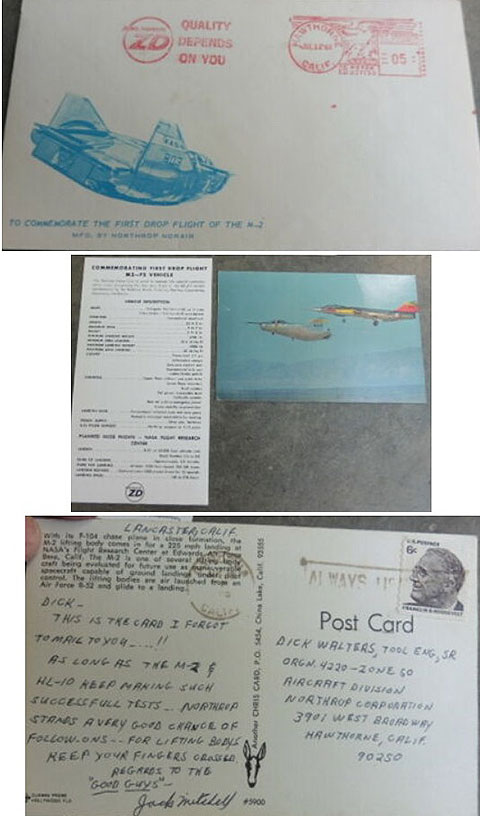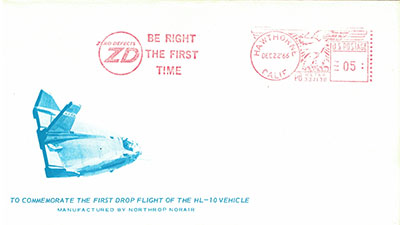Space Cover 648: M2-F2 Glide FlightsThe success of NASA Dryden Flight Research Center's M2-F1 lifting body program led to the development and construction of two heavyweight lifting bodies based on studies at NASA's Ames and Langley research centers — the M2-F2 and the HL-10, both built by the Northrop Corporation.
On March 23, 1966, the M2-F2 made its first captive flight, attached to its B-52 carrier aircraft. The first glide flight took place on July 12, 1966, piloted by Milt Thompson - dropping away from the B-52's wing pylon at an altitude of 45,000 feet and reaching a top speed of about 450 miles-per-hour.
Shown at the top of the image, a cover was produced by Northrop Corporation "To Commemorate The First Drop Flight Of The M-2" with a meter cancel from Northrop's Headquarters in Hawthorne, California on July 12, 1966.
Also shown is a postcard written in 1966 by Jack Mitchell who worked on the M2-F2 program and mailed to Dick Walters an engineer at Northrop headquarters:
As long as the M-2 and HL-10 keep making such successful tests ... Northrop stands a very good chance of follow-ons ... for lifting bodys. Keep you fingers crossed. Regards to the "Good Guys."
However, this was not to be, as on May 10, 1967, the sixteenth and last glide flight ended in disaster as the M2-F2, with pilot Bruce Peterson at the controls, slammed into the lakebed on landing. Peterson suffered a pilot induced oscillation (PIO) as it neared the lakebed.
The core problem was that the wings of the M2-F2 produced considerably less "roll authority" than most aircraft resulting in less force available to the pilot to control the aircraft when a roll occurs. During this flight the M2-F2 rolled from side to side as Peterson tried to bring it under control. Peterson recovered, but then observed a rescue helicopter that seemed to pose a collision threat.
Distracted, Peterson drifted in a crosswind to an unmarked area of the lakebed where it was very difficult to judge the height over the ground because of a lack of markers that were provided on the actual lakebed runway.
Peterson fired the landing rockets to provide additional lift, but he hit the lakebed before the landing gear was fully down and locked. The M2-F2 rolled over six times, coming to rest upside down. Peterson was pulled from the vehicle and rushed to the hospital where he recovered but lost vision in his right eye due to a staphylococcal infection.
Portions of M2-F2 footage including Peterson's crash landing were used for the 1973 TV series "The Six Million Dollar Man." Interestingly, some shots during the opening credits of the series also showed the later HL-10 model, during release from its carrier plane, a modified B-52.
Four pilots flew the M2-F2 on its 16 glide flights. They were Milt Thompson (five flights), Bruce Peterson (three flights), Don Sorlie (three flights) and Jerry Gentry (five flights).
The M2-F2 was rebuilt at Dryden and designated the M2-F3, it was modified with an additional third vertical fin—centered between the tip fins to improve control characteristics.
Martin Marietta would be the contractor to build the X-24A and X-24B lifting bodies.
















